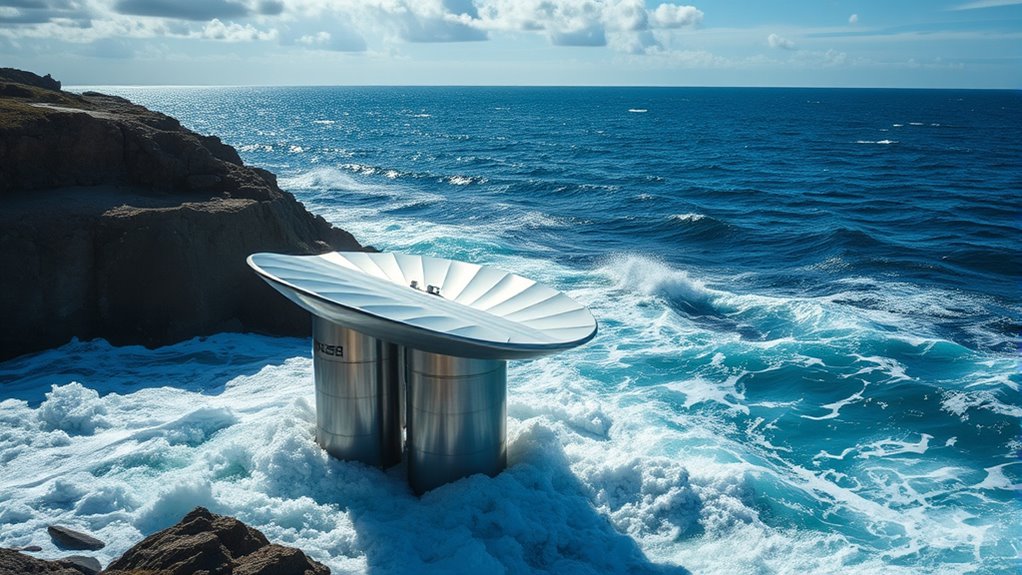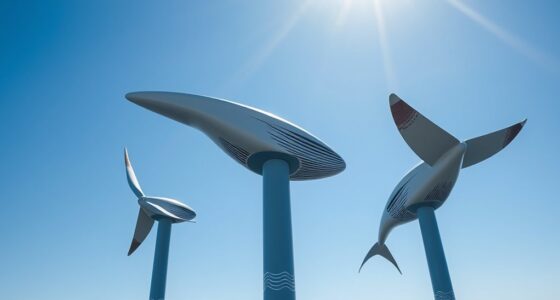Ocean-powered batteries harvest wave energy using compact, durable generators that convert ocean motion into clean electricity. These systems are lightweight, easy to deploy, and can operate autonomously for over 100 days, making them ideal for coastal areas. They’re built from corrosion-resistant materials and include advanced control systems for efficiency. If you want to discover how these innovative solutions can power communities or marine operations, there’s more to explore below.
Key Takeaways
- Ocean-powered generators use wave energy converters to capture mechanical motion and convert it into electrical power.
- These systems incorporate advanced power take-off and control algorithms for efficient energy harvesting.
- Energy is stored in durable battery banks, enabling continuous power supply independent of the grid.
- Modular, lightweight designs allow quick deployment and easy maintenance in harsh ocean conditions.
- Wave energy’s high density offers a vast, clean, and sustainable source for powering batteries and coastal communities.

Ocean-powered batteries are transforming how we generate and supply renewable energy, especially in remote coastal areas. These systems harness the natural motion of waves to produce reliable, sustainable power that can replace traditional diesel generators. With compact wave-powered generators weighing around 30 pounds, you can deploy them quickly—often in under five minutes with just two people. This lightweight design makes installation and maintenance straightforward, allowing for rapid setup and easy recovery when needed. The devices are usually point-absorber wave energy converters tethered securely to the seabed, capturing wave motion efficiently. Instead of using hydraulics, gear-based energy conversion systems are preferred because they’re more compact and reliable, ensuring consistent performance even in harsh ocean conditions.
Compact, lightweight ocean-powered generators harness wave motion for reliable, quick-deploy renewable energy in coastal areas.
You benefit from the impressive operational performance of these wave-powered systems. They can run autonomously for extended periods—more than 100 days without interruption—delivering dependable energy. Compared to conventional batteries, ocean-powered batteries support operational uptime of around 84%, a significant improvement over the less than 1% uptime typical of battery-only solutions. Multiple units can be combined with power take-off systems and rotary electrical generators to store energy effectively in battery banks. This setup provides a steady power supply, independent of the electrical grid or single-use batteries, making your operations more resilient and sustainable. Plus, wireless charging technologies, like those using seawater, are being developed to facilitate underwater vehicle recharging, further enhancing the system’s versatility.
The core of these systems lies in advanced energy conversion technologies. Sophisticated control algorithms optimize how wave energy converters respond to wave patterns, capturing maximum energy. Power take-off systems efficiently transform the mechanical oscillations from waves into electrical energy, designed for robustness to withstand constant exposure to oceanic elements. Modular and compact PTO architectures make maintenance easier and reduce downtime, keeping your system operational longer. Synchronizing device motion with wave patterns boosts efficiency, ensuring you get the most energy possible from each wave. Research continues to improve these technologies, making them more efficient and accessible for widespread use.
Durability and longevity are key priorities in material science. These devices are built from corrosion- and fouling-resistant materials that extend their operational lifespan. Ongoing research aims to improve durability even further, reducing maintenance costs and operational disruptions. Modular designs allow for easy part replacement or upgrades, helping you keep your system at peak performance during storms or extreme weather. The environmental resilience of these systems ensures they maintain energy production even under the most challenging conditions. Incorporating advanced materials can significantly enhance their lifespan and reduce maintenance needs over time.
Wave energy is incredibly dense—20 to 60 times more than solar or wind—making it a powerful resource. The potential to power over 100 million U.S. homes highlights its vast untapped capacity. By harnessing ocean wave energy, you can generate clean electricity with minimal environmental impact, reducing reliance on fossil fuels and lowering CO2 emissions. These ocean-powered batteries offer a sustainable, cost-effective solution for coastal communities and marine operations, providing a reliable stream of renewable energy that supports a cleaner future.
Frequently Asked Questions
How Long Do Ocean-Powered Batteries Typically Last?
You’re wondering how long ocean-powered batteries typically last. These batteries often have an operational lifespan of around 20 to 25 years, thanks to advanced materials and engineering that combat harsh marine conditions. Their durability is proven through extensive field tests, with some systems operating continuously for months. Proper maintenance and innovative design help extend their life, making them reliable for long-term renewable energy storage in challenging ocean environments.
Are Ocean-Powered Batteries Environmentally Safe?
You wonder if ocean-powered batteries are environmentally safe. These batteries tend to be safer than traditional types because they use seawater electrolytes, which are less toxic and nonflammable. They also reduce reliance on land-based mining, lowering ecosystem disruption. However, risks remain if they’re discarded improperly, as heavy metals can leak and cause pollution. Proper recycling and lifecycle management are essential to guarantee they stay environmentally friendly during their use and disposal.
What Are the Costs of Deploying Ocean Wave Energy Systems?
You’re curious about the costs of deploying wave energy systems. Currently, installation costs average around US$7,247 per kilowatt, but are expected to drop to US$1,180 by 2050 due to technological advances. You’ll also face high operational expenses, like maintenance, which can be about $0.07 per kilowatt-hour. Factors like vessel costs, site conditions, and scale influence overall costs, but economies of scale and experience will help reduce expenses over time.
Can Ocean-Powered Batteries Operate in Rough Sea Conditions?
You might wonder if ocean-powered batteries can work in rough seas. The answer is yes, but only if they’re specially designed for such conditions. You need robust casings that resist shocks, vibrations, and water intrusion. Using corrosion-resistant, sealed batteries like LiFePO4 helps maintain performance amid waves and spray. Proper maintenance, protective coatings, and safety features are essential to guarantee these batteries operate reliably and safely during turbulent sea states.
How Do Ocean Batteries Compare to Traditional Energy Storage?
You might think traditional storage always wins, but ocean batteries offer unique advantages. They have a longer lifespan—up to 50 years—and use abundant, eco-friendly materials, unlike lithium-ion options that degrade faster and rely on scarce resources. Plus, ocean systems have nearly zero self-discharge, making them perfect for long-term storage. While efficiency is slightly lower, their durability, environmental benefits, and massive scale make them a compelling alternative for sustainable, large-scale energy storage.
Conclusion
You can’t judge a book by its cover, and the same goes for ocean-powered batteries. These innovative devices harness wave energy, offering a sustainable solution for the future. By tapping into the ocean’s endless power, you’re helping reduce reliance on fossil fuels and protect our planet. Embracing such technology shows that small steps can lead to big change. So, stay hopeful—every drop counts in building a cleaner, greener world.










